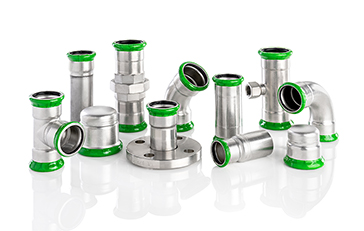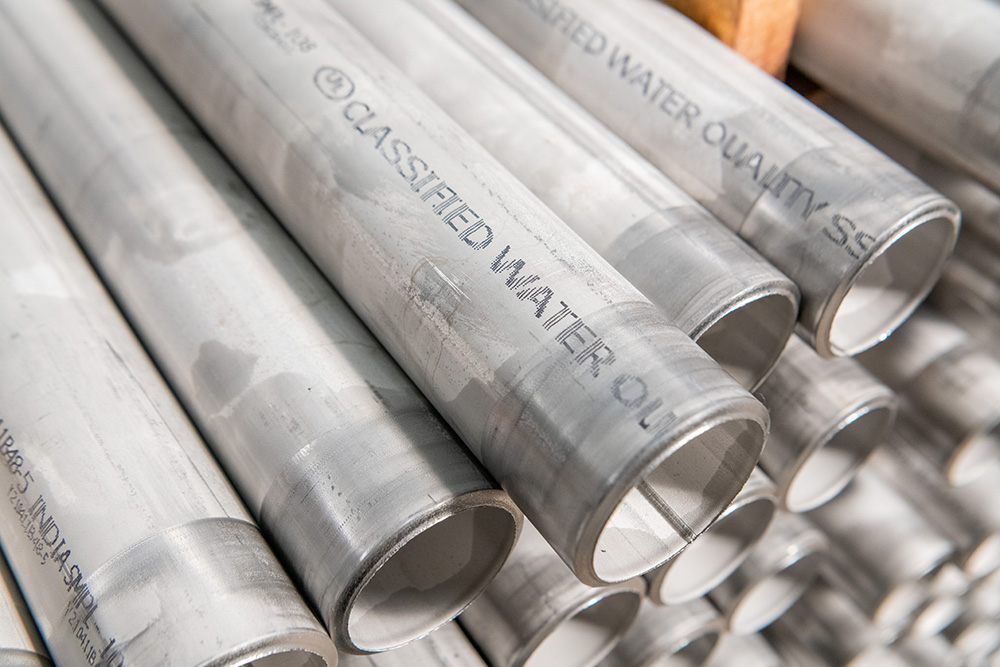When you work in trades, especially plumbing, electrical, and mechanical, finding ways to optimize your installation process to operate more efficiently and economically is an ongoing process. However, one option that you may not have considered before now is the possibilities made available using press fittings. Though they are more commonly found in other metals, many tradesmen find stainless steel press fittings to be a great option to consider when having to get a lot of work done quickly without spending a lot of money in the process.
In this post, we'll look at press fitting systems, whether they're a good option, what they're used for, how they're done, and in what situations press fittings provide you with superior options.

Unlike other forms of pipe fittings that require knowledge and training in welding, brazing or soldering, press fittings are exactly what they sound like - fittings that are pressed into place, then tightened using a mechanical tool to create a firm joint, quickly and easily in a short period of time. Because they require a significantly smaller amount of teaching to get right and are so fast to put into place, many trade services have switched to them due to the significant schedule savings that can be realized during the installation process.
These types of systems encompass a wide range of products, often manufactured for different types of purposes, but those who have used them find them by all accounts to be a great use of limited resources of time and effort on the job site, especially when your schedule is tight.
With sealing elements on the inside and hydraulic tools that tighten down the connection, press fittings are as solid as regular welded, braised or soldered connections, providing an easier, faster solution to forming connections and joints. Also, because no heat is required when using the press tools, it avoids the potential for fire hazards and all of the related regulations and safety equipment that is needed. This makes them a great option in enclosed spaces or short crawlspaces where heat-based joint systems can cause serious problems if not carefully and cautiously monitored due to the strong temperature range that happens during the soldering process.
As with all new technology, many commercial trade services has been cautious to accept this method of creating joints in tubing and piping but have begun to agree that provided that a trusted brand is used in the process, a system with stainless press fittings is just as good as one that has been soldered using copper tees or bronze connectors.
There are a wide range of uses for press fittings, though the usage will dictate the type of press fittings to be used, specifically whether they are copper, which can corrode, or stainless steel, which can protect much better against corrosion, but also harder to use press tools on and more expensive. For most situations, these two metals will cover virtually every contingency, as carbon steel can also rust or corrode, often much faster than copper will, which is why you'll only rarely see carbon steel on the market.
As a short rundown of their variety of applications, they can be used for gas, chemicals, and water with equal outcomes, along with HVAC systems which may be under low or high pressure. The fine level of control these fittings provide makes it much easier to get the job done the first time, especially on a tight schedule.
Not only are press fittings as reliable as traditional methods of joining copper or steel pipe connections on the market, they can actually enhance performance, providing a more complete seal which saves you limited resources on the job and keeps you on schedule. Because the fittings can be used in areas of low reach or angle, they're much easier to install in tighter spaces, and have been used from very small sizes up to extremely large installations, such as 50-ton cooler units.
On account of the short history of the press fitting, many contractors have not yet reached their final judgement to pass the press fitting into the same level of dependency as welded, soldered or brazed connections. This is why it's understandable that many services choose to wait until more of the industry has taken on these new fittings, but overall, the many applications and quick process involved in installing these connections by hand make it easy to see that they will be more in demand as industry experience continues to grow.
Though there are many applications for press fitting products to be taken into account, the end process is almost always the same. Because the system is designed to provide a dry connection, it follows a very specific and very simple process, a boon when you're on a tight schedule. The pipe is cut to length, then deburred on the inside and outside. The insertion depth is marked near the pipe end using a jig, the pipe end is inserted into the fitting to the marked depth, then the fitting is crimped.
The tight crimp extends around the entire fitting, creating a tight seal that is reinforced by the sealing element, which also prevents any unintentional leaks around the seam between the fitting and the pipe. This easy process creates a solid, dry seal that is much easier to use than other products while easily pulled off even in tight conditions, provided that you select the appropriate insertion depth and steel press tool for the pipe size.
When you use stainless press fittings, you need something to provide a quick and easy but strong connection between the fitting and the pipe. This is where the press tool comes into play. Available in either hand or powered versions, press tools have jaws in various sizes for different applications that provide a consistent fit around the press fitting and is designed to crimp the fitting down tightly onto the pipe, creating a dry seal. To get the proper fit, you'll need to select the proper press tool, depending on the specific size of the pipe.
Once you've been able to select the right press tool from your collection, you'll place it in contact with the fitting at the appropriate location for your specific type of press fitting. You'll then shut the steel press around the fitting, where it's designed to create a tight crimp. Combined with the quick and easy assembly process, you'll find that you have a lot more time on your schedule and see superior performance in your fittings, even in hard to access areas.
In a single word, yes! Stainless steel press fittings are included in a wide range of national and international building codes, such as using them with Schedule 10 or schedule 5 pipe in the International Fuel Gas Code, the International Plumbing Code and ASME standards. However, because it's not as malleable as copper is, it's recommended that you use a powered press tool from a trusted brand system that you have faith in. Among the industry's front runners is Milwaukee's press tool, which features a fairly complete system of common sizes designed for the most common applications in MEP services. These products work well with stainless steel pipe in a variety of conditions and deliver the needed pressure around the circumference of the fitting.
READ MORE ABOUT STAINLESS STEEL

Pressing pipe depends on the profile of the press fitting. StainlessPress® Fittings by Merit Brass Co. are an "M" profile which mates with schedule 5 or schedule 10 stainless steel pipe. The stainless pipe is cut to length, the stainless steel pipe deburred, the insertion depth marked, the pipe inserted into the fitting and the fitting is tightly crimped around the pipe, providing a solid joint. As with copper, the seal created by the tight crimp is reinforced by the sealing element preventing unintended leaks between the fitting and the pipe.
The process is much easier than traditional methods and still creates a solid, dry seal. However, given the much harder properties of stainless steel press fittings, most MEP service providers will select a press tool that is powered independently, as it can be very difficult to tighten the crimp around the pipe using a hand-pressing tool.
Type M press fittings only use the fitting itself to restrain the joint, making them easier and faster to install and are a great option in most circumstances. However, in very specific situations, a Type B press fitting may be specified in a design, as it includes a swinging restraint on the fitting to prevent the pipe from blowing out, but for the most part, Type M fittings are used in the vast majority of situations.
If you're of a mind to learn more about the stainless steel press fittings we've mentioned above, the experienced professionals at Merit Brass would be happy to help. Please feel free to reach out today for more details if you have a question or for more general information about our extensive selection of press fittings:
SOURCES INCLUDE:
https://hvac-talk.com/vbb/threads/2219339-Press-fittings
https://www.youtube.com/watch?v=8e8rJ_RYlh0
https://www.youtube.com/watch?v=S5NWZMzPZBA
3/28/2025 2:01:23 PM